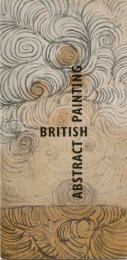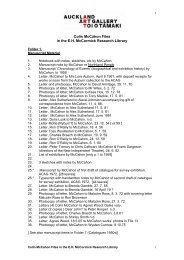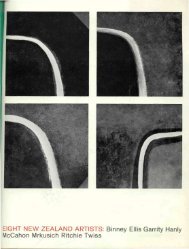Create successful ePaper yourself
Turn your PDF publications into a flip-book with our unique Google optimized e-Paper software.
Ceramics / Glass / StoneMake certain your path is clear prior to moving anobject. Never walk backwards while carrying a museumpiece.When you must handle or move an object, useclean, dry hands. The surface of most glass and ceramicobjects is smooth and slippery, and the frequently recommendedwhite gloves have a tendency to slip.Remove lids and loose parts prior to moving. Smallobjects transport well in a padded box or basket with ahandle; larger objects should be transported on a paddedcart or dolly.For cleaning, do not immerse pieces in warm water,as some old adhesives come apart.Never use epoxy resin or super-glue to repair yourbroken pieces, as it discolours and is virtually impossibleto take apart. For such repairs, seek the advice of aconservator.Storage and DisplayCeramics and glass should be displayed in a stable environmentand extremes of temperature or heat should beavoided. Lighting for display cases should beexternal so as not to cause heating of theobjects.Care should be taken toensure that the artefacts aredisplayed or stored in asecure manner to avoidbreakage or abrasion.There should be novibration which would cause damage by wear or creep,causing the object to move gradually to the shelf edge.If necessary the shelf edge could have a lip or band ofmaterial attached to it for safety purposes. In storage,small objects that are inclined to roll should berestrained from doing so with wedges of foam or tissue.Stacking flat objects such as tiles, plates or plaquesshould be avoided as this will increase stresses, increasingthe possibility of accidents and inhibiting accessibility.If space is limited and there is no alternative thenonly objects that are sound and stable should bestacked with layers of padding (tissue or foam) betweenthem.The interior of the display case or storage unitshould be easily accessible to facilitate removal orinstallation of objects. Ideally, retrieval should notrequire the movement of artefacts over the top of others.But if this is necessary, then objects should be storedaccording to their size with the smallest at the front.Display cases should ideally be constructed of inertmaterials such as metal and glass that will not emit anyharmful corrosive vapours. If glass is to be used it shouldbe laminated rather than toughened to avoid any risk tothe contents of the case should the glass be broken.Ceramics, glass and stone should be covered in storageto prevent dust settling and, where possible, displayedin a dust-free environment. Display cases shouldbe as airtight as possible to reduce the impact of outsideenvironmental changes and to slow the entry ofgaseous and particulate pollutants.The most common form of damageto ceramics and glass is the resultof mechanical shock upon impact,caused by direct or indirect humanintervention.48
















